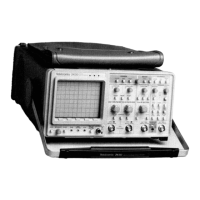6-7
Power is distributed to the different circuit boards
through interconnect assemblies consisting of one or more
connectors. The diagrams showing these assemblies (or
partial assemblies) provide the interconnecting assembly
(wire, plug, and/or jack) numbers, as well as the number
Power Distribution
Power distribution is traceable through the schematic
diagrams in the "Diagrams" section. The low-voltage
power supplies originate on the Power Supply board and
are schematically illustrated in diagrams 22 and 23. The
high-voltage and +61 V power supplies, originating on the
High Voltage board, are shown in diagram 19. Any power
supply can be tracked back to its diagram and forward to
other circuitry illustrated on different diagrams.
Circuit Board Interconnections
A circuit board interconnection diagram is provided in
the "Diagrams" section to aid in tracing a signal path or
power source between boards. All wire, plug, and jack
numbers are shown along with their associated wire or pin
numbers.
Circuit Board Locations
The placement of each circuit board in the instrument is
shown in a board locator illustration. This illustration is
located on the foldout page along with the circuit board
illustration.
The locations of waveform test points are marked on
the circuit board illustrations with hexagonally outlined
numbers corresponding to the waveform numbers on both
the schematic diagram and the waveform illustrations.
Circuit Board Illustrations
Circuit board illustrations showing the physical location
of each component are provided for use in conjunction
with each schematic diagram. Each board illustration is
found in the "Diagrams" section on the back of a foldout
page, preceding the first schematic diagram(s) to which it
relates.
reference numbers (enclosed in hexagonally-shaped boxes)
are also shown on each diagram. Waveform illustrations
are located adjacent to their respective schematic diagram.
Component numbers and electrical values of com-
ponents in this instrument are shown on the schematic
diagrams. Refer to the first page of the "Diagrams" sec-
tion for the reference designators and symbols used to
identify components. Important voltages and waveform
Functional blocks on schematic diagrams are outlined
with a wide grey line. Components within the outlined area
perform the function designated by the block label. The
"Detailed Block Diagram Description" in the "Theory of
Operation" uses these functional block names when
describing circuit operation, aiding in cross-referencing
between the two circuit descriptions and the schematic
diagrams.
Schematic Diagrams
Complete schematic diagrams are located on tabbed
foldout pages in the "Diagrams" section. Heavy black lines
that enclose portions of the circuitry represent the circuit
board on which the enclosed circuitry is mounted. The
assembly number and name of the circuit board are shown
near either the top or the bottom edge of the diagram.
Diagnostic Firmware
The operating firmware in this instrument contains diag-
nostic routines that aid in locating malfunctions. When
instrument power is applied, power-up tests are performed
to verify proper operation of the instrument. If a failure is
detected, this information is passed on to the operator in
the form of a crt readout error message. The failure infor-
mation directs the troubleshooter to the area of failing
circuitry. If the failure is such that the processor can still
execute the diagnostic routines, the user can call up
specific tests to further check the failing circuitry. The
specific diagnostic routines are explained later in this
section.
TROUBLESHOOTING AIDS
Preventive maintenance performed on a regular basis
should reveal most potential problems before an instru-
ment malfunctions. However, should troubleshooting be
required, the following information is provided to facilitate
location of a fault. In addition, the material presented in
the "Theory of Operation" and "Diagrams" sections of
this manual may be helpful while troubleshooting.
INTRODUCTION
TROUBLESHOOTING
Maintenance-2430 Service

